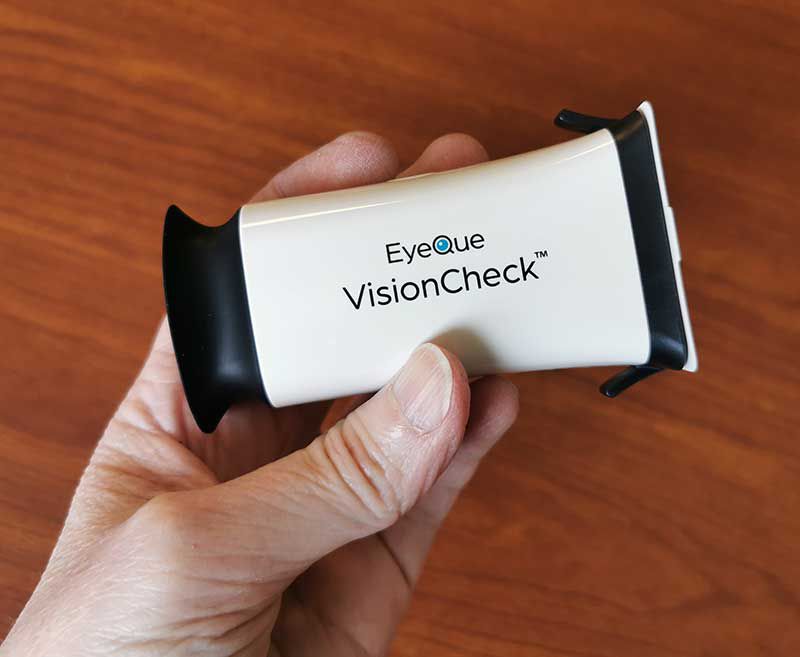
REVIEW – Due to my nearsightedness and astigmatisms, I have worn glasses with high index lenses since the third grade. I have my eyes checked each year by an optometrist and other than the drops to dilate my eyes, it’s a pretty stress free appointment. I know a lot of people who don’t go to a yearly eye exam and I wonder if it’s just because they don’t want to make time for the appointment. If that’s the case, the EyeQue VisionCheck is designed to allow you to quickly check your vision using a small device and your smartphone. Can it replace your eye doctor? Let’s find out.
What is it?
The EyeQue VisionCheck is a tool that you can use to measure the lens power needed to correct nearsightedness, farsightedness, astigmatism, and near vision ADD. Once the test is completed, you are given your prescription details, and can order glasses if you need them.
What’s in the box?
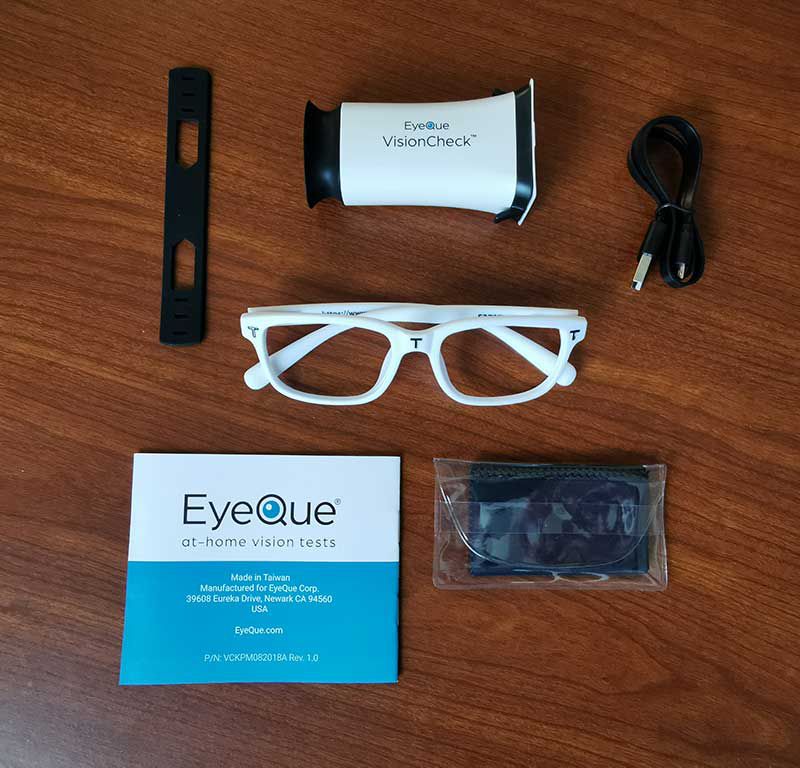
- EyeQue VisionCheck
- micro USB charging cable
- Attachment strap
- Cleaning cloth
- Pupillary distance glasses
- Quick start guide
Design and features
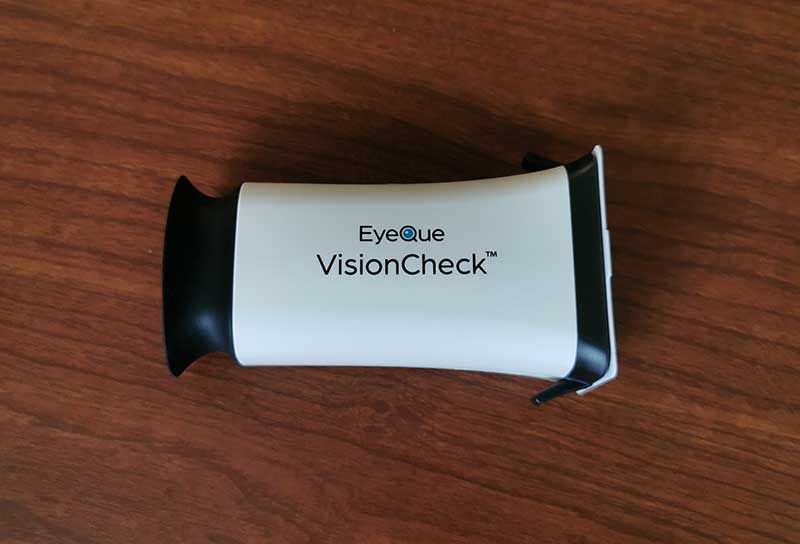
The EyeQue VisionCheck is a small device that looks a bit like a monocular with an eyepiece on one end.
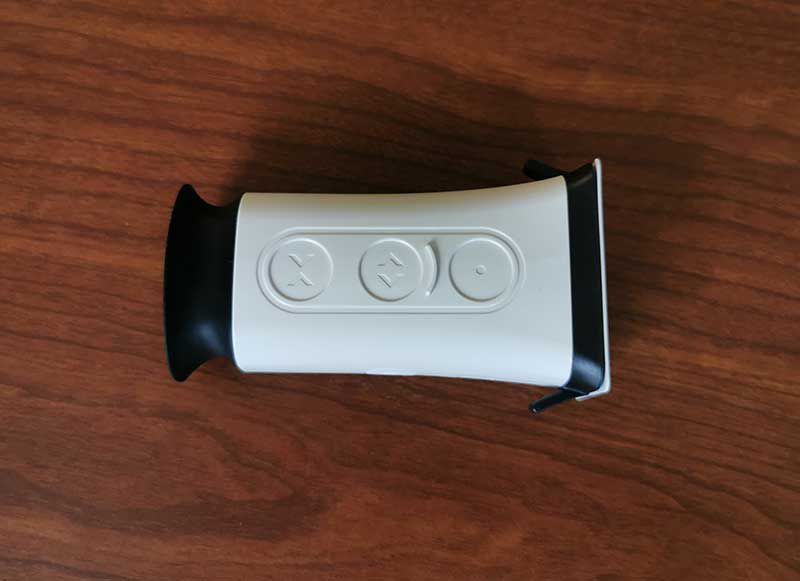
There are three touch-sensitive buttons on the top of the device, a power button on the side, and a micro USB port on the same side as the power button which is used to charge the device.
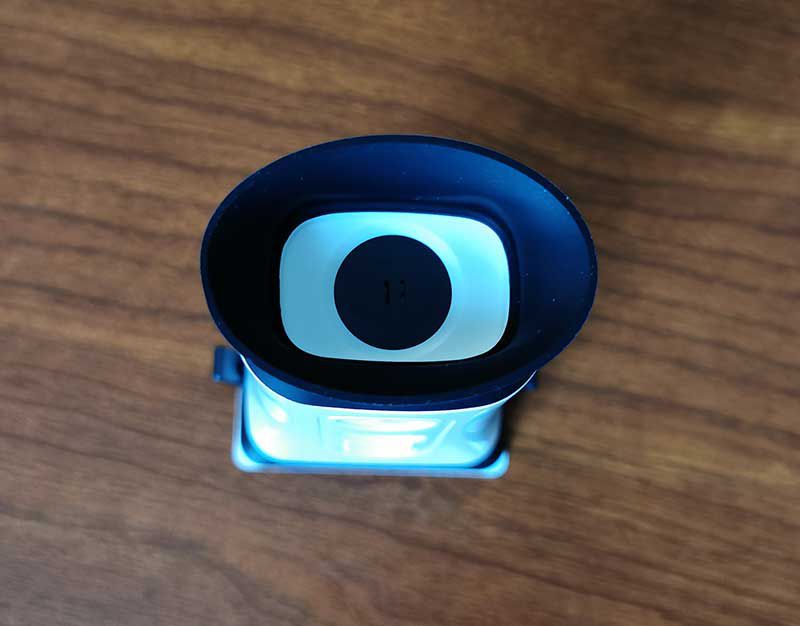
The eyepiece has a soft rubber cup around it to make the testing process more comfortable.
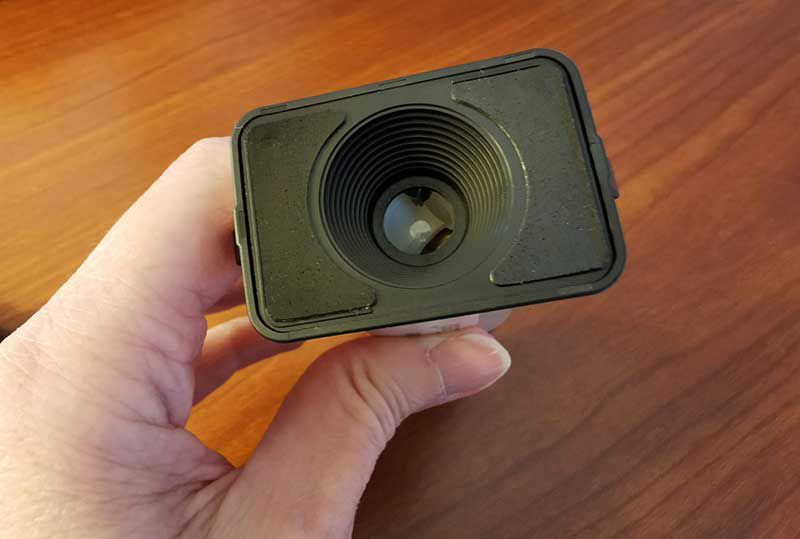
The opposite end has a lens and sticky pads that allow you to “mount” the EyeQue over your smartphone’s display.
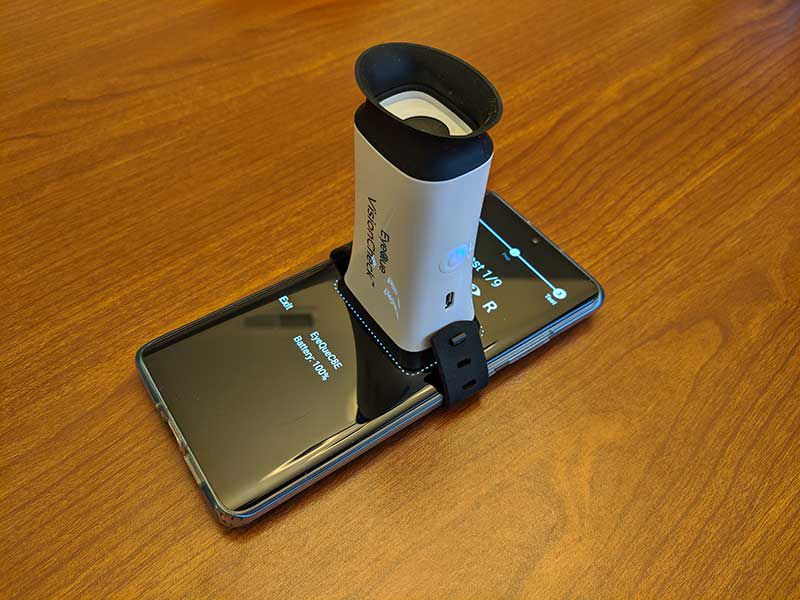
The VisionCheck is then secured with the included silicone strap. The strap rested right over the power button on my Huawei P30 Pro and kept powering off the phone. I ended up having to use the loosest setting on the strap.
How does it work?
If you’ve had your eyes checked before, you’ll probably remember one of the first things that you have to do is sit behind a big machine and look through an eyepiece where you’ll see a barn or a balloon in the distance.

This machine is called an Auto-Refractor and as you look at the barn or balloon, the machine will shine light into your eye and automatically adjust the focus to measure the shape and size of your cornea to provide the doctor with a base prescription.
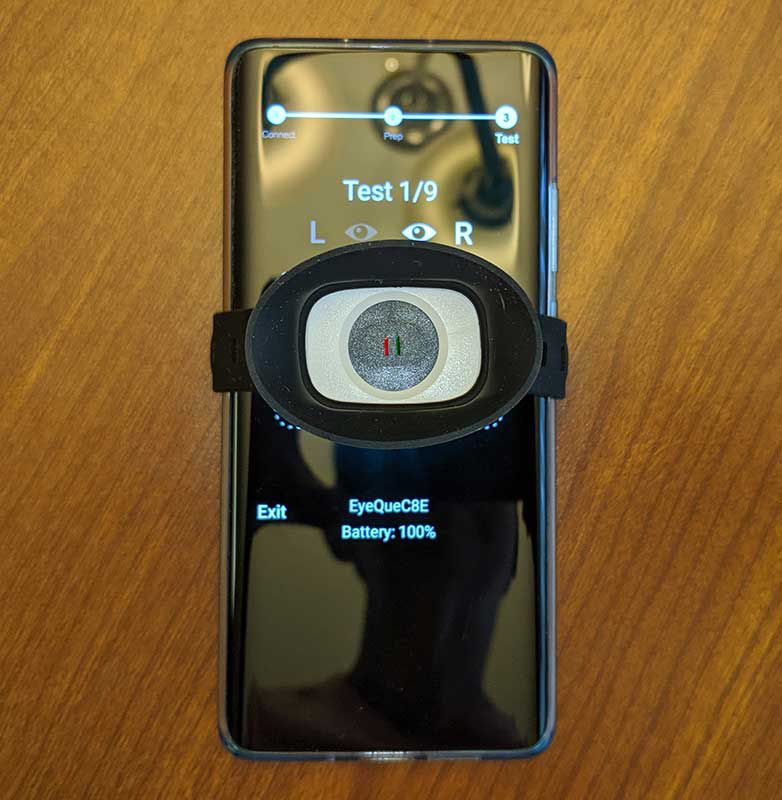
From what was was explained to me, the EyeQue VisionCheck does the opposite of the Auto-Refractor.
The VisionCheck projects images from your smartphone screen through your pupil and onto your retina. Your refractive error (nearsightedness, farsightedness, and astigmatism) causes you to see these images in a certain way. Based on the way you conduct the vision test, our technology calculates your EyeGlass Numbers; the power needed to correct your refractive error.
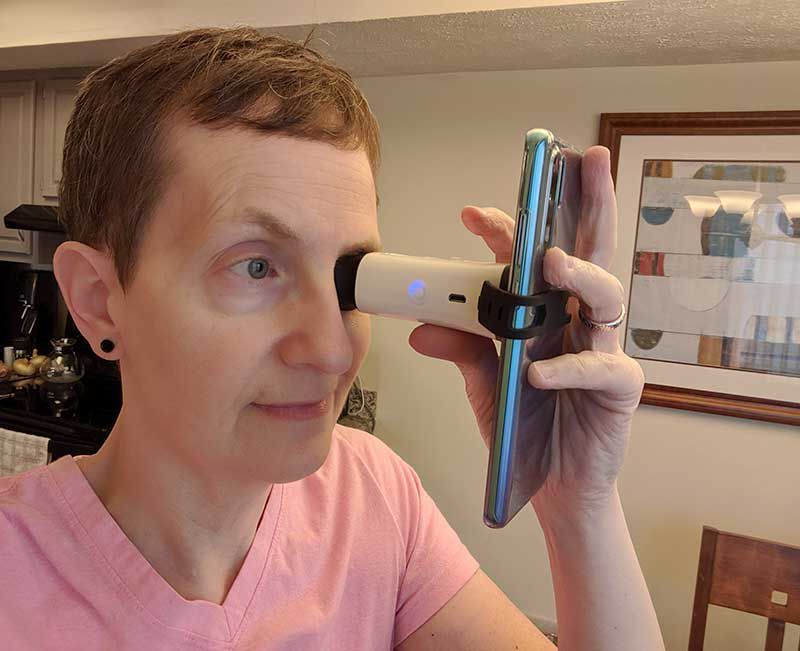
You remove your glasses (if you wear them) and test one eye at a time. Each test has 9 steps where you overlap a red and green bar by pressing the buttons on the VisionCheck device until the bar turns yellow. At that point, the bars rotate into a different position on the screen and you overlap them again and so on for 9 times.
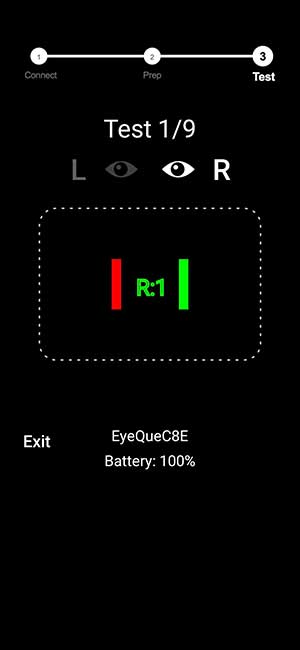
When you’re finished testing one eye, you do the same test with the other eye. When all the tests are completed, you’re given your prescription.
When I first started testing the VisionCheck, I had a hard time seeing the bars through the device without pivoting my head or the device. But as I continued trying it, the bars were easier to see most of the time. But sometimes I would have to “search” for the bars.
A full test of both eyes takes as long as you need to take in order to overlap the bars. There is no time limit. I actually became pretty fast at it. That said, I had to take the tests several times before the software gave me a prescription that I could use to order glasses.
But before you can order glasses, you also have to take the PD test. PD stands for pupillary distance and it just means the distance between your pupils.
To test your PD, you put on the provided glasses and then use the VisionCheck app which has you line up your face and eyes on the screen.
What I like
- Much less expensive than an appt at the eye doctor
- Portable device
- Easy to use
What I’d change
- Does not replace a checkup where the doctor checks for physical issues with your eyes
- Results are only as accurate as how you see the bars in the device
Final thoughts
It should be obvious that this device does NOT take the place of a doctor checking your eyes, so I asked EyeQue to tell me why they are selling this device. Here is their response.
EyeQue is designed to be used between doctor’s visits to get more people engaged in their eye health. The convenience of having these devices at home means you can take a quick test as often as you’d like to track vision changes for yourself and others in the household, and have the information available to share with doctors during regular exams.
EyeQue’s at-home vision tests give people an accurate, affordable, convenient way to be invested in their eye health. In a recent customer survey, nearly 90 percent of people who purchased glasses using their EyeGlass Numbers said they performed the same (33 percent) or better (53 percent) than their previous glasses.
I find devices like the EyeQue to be the future of medicine and how we may be doing our own medical checkups in the future. I realize that devices like this one won’t take the place of real doctors, but using the EyeQue as a tool to keep an eye (sorry) on your prescription in-between visits can help you know if/when there might be problems with your eyes and prompt you for a visit with your doctor before your yearly visit.
Price: $69.00
Where to buy: Amazon
Source: The sample for this review was provided by EyeQue.

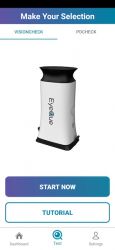
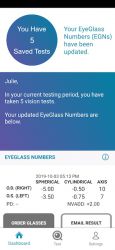
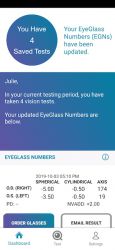
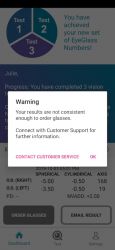
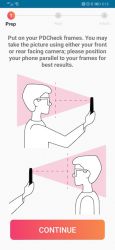
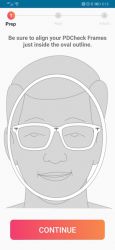
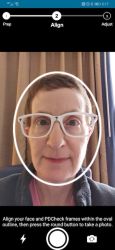
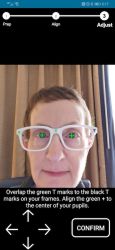
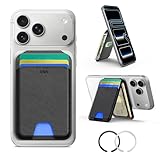

Gadgeteer Comment Policy - Please read before commenting
Except that there are many ocular problems that make no change in your glasses prescription. And most prescriptions are unlikely to change much, if at all, during the year or two between visits. So this gadget might make a person feel like they are monitoring their eye health when the really are not. Pamela Dobson, DO Ophthalmologist
Um…and you have no conflict of interests, of course? Good. That’s very professional.
Well… I’m an eye doctor as well. I think I’ll order one and check it out. Prescription glasses can be very expensive, so you want to have the most accurate refraction possible.
There are a lot of subtle nuances to prescribing a comfortable prescription … such as not “over minusing” and avoiding anisometopia. Still, I’m willing to try it with an open mind!
Tim, can you explain what anisometopia is?
Anisometropia (I misspelled it) is when a prescription is too “different” between the eyes.
Strong/thick glasses cause images to look slightly larger or smaller than they look in real life. If the glasses are balanced (similar thickness), the brain quickly adapts and things look normal.
However, if one eye has a much thicker/stronger prescription — than image size difference between the eyes is too great. This can cause double vision or general discomfort when wearing them.
There are many such nuances when prescribing glasses, which limits the actual usefulness of at-home testing. It might be a good screening test … but a doctor at your nearby Walmart will do a MUCH better job at getting your glasses to work.
I find these devices interesting as a potential screener for third-world countries … but even this market is shrinking as poorer countries roll out better access to eye care.
If interested in eye stuff, you may find my website useful:
http://www.timroot.com
Thanks! I’ve been following the-gadgeteer for over a decade (back when Judie was around). Keep up the good work!
Thanks for the explanation! I agree that a device such a this one won’t replace a doctor.
Hi Tim
Could you please share your findings about this product?
Thank you
Hamee
I order my glasses from Costco, requiring a prescription. Does the prescription you get with this only allow you to order glasses from them? What are the prices on their glasses?
Cassie, you can use the prescription to order glasses from any place that sells glasses. They provide a standard prescription. They are partnered with Zenni.
Thank you so much! That certainly makes it much more interesting.
this is most interesting! does anyone know how it actually works? ie how does the distance of 2 bars on a screen translate to correction factor?
I had LASIK surgery done 13yrs ago but the most reputable Doctor in our 200mi radius. Anyway, since that time I’ve developed a problem where I get double vision often (heavy daily eye strain as a Programmer for 30+ yrs), when I go for checkups they say I have 20/20 and I get nowhere. Of course I’m not suffering the double vision when I go for my exams. The idea of this gadget intrigued me as it would allow me to test without waiting weeks.
Thank you,
Patrick
Before I deployed for Desert Storm in 1990, a military eye doctor used a similiar
Device to test get a prescription for my eyes. I did nothing but look into a device to see a barn image. He ordered military glasses with the prescription he got from that simple 5 second test. I could see perfectly with my new glasses. I was impressed. I asked my eye doctor this last time why she did not use this automatic method to get a prescription. She said the conventional eye test was better and more accurate. Really? I am not convinced. I will buy the eyeque device. It made a believer out of me.
Good idea, that’s why I supported the crowdfunding campaign, but unfortunately completely useless for me. I am farsighted with astigmatism and with my glasses (eye measurements from an optician, they can do this better in Germany than the ophthalmologists). With this device I am suddenly short-sighted and the scatter of the values is much too high. The support is helpful, but cannot change anything.